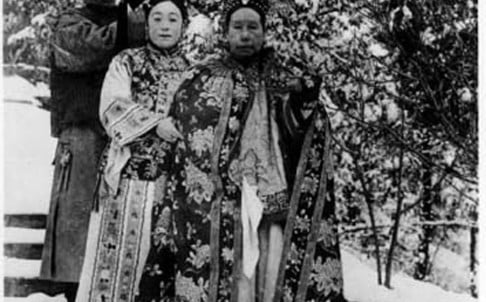The tomb of Empress Dowager Cixi (right) was looted by a warlord in the 1920s. Photo: Courtesy of Hong Kong University Press
China is set to spend more than 700 million yuan in an effort to revamp the Eastern Qing Tombs, a royal mausoleum complex from the country’s last imperial dynasty northeast of Beijing, a report said on Wednesday.
The Beijing Times reported that the mausoleum 125 kilometres northeast of Beijing had been severely damaged in two major looting incidents, and the wooden structure and coffins in some of the tombs had been left open to the elements, Wang Zhaohua, deputy director of the Administrative Bureau of Cultural Relics at the mausoleum, told the newspaper.
The restoration project will cover the tombs of eminent Qing emperors, such as Kangxi and Qianlong, and Empress Dowager Cixi, whose corpse was ravaged when a warlord ordered a looting of the complex in 1920s.
Wang said the empress’s corpse, which was discovered intact, had now turned mummified. Her coffin, which was made of Pheobe zhennan – a rare and extremely durable wood, sealed and painted with 49 layers – was designed to protect her body from decay, but had begun to deteriorate when looters forcefully opened the underground tomb and exposed it to outside temperatures and humidity.
The project will aim to create an environment with low oxygen levels to restrain bacterial growth in a bid to preserve the coffin.
Emperor Qianlong’s tomb is also at risk, suffering from leaks and flooding, Wang said.
The Eastern Qing Tombs are the largest and best preserved mausoleum complex in China, with five emperors, 15 empresses, 136 imperial concubines, three princes and two princesses of the Qing dynasty found buried there. The revamp of the mausoleums of Qing emperors and empress will cost more than ten million yuan each, according to Wang.
The complex was first looted on a large scale in 1928 by warlord Sun Dianying, who pretended that he was leading his army there to practice military manoeuvres. One team of tomb raiders blew up the entrance and doorways of the underground palace of Yuling, where the remains of Qing Emperor Qianlong were laid to rest. The raiders took away any object of value and pried open the coffins of the emperor, his two empresses and three imperial concubines, leaving their skeletons scattered around. Researchers are now only able to identify just one of the six corpses, as they were badly mixed.
Another group of soldiers opened the tomb of Empress Dowager Cixi. Robbers pulled her body from the tomb to reach jewels hidden under her corpse, and an imperial robe, shoes, socks and jewellery that she wore were all stolen, as well as a massive pearl put in her mouth to keep her body from decomposing. Even her undergarments did not survive and were removed in the raid.
The second looting occurred in 1946 during China’s civil war, where the complex was left almost unguarded. Only Xiaoling, the tomb of Emperor Shunzhi, was spared from looters, thanks to prevalent folk tales suggesting that the emperor was not buried there.

The scale of the architecture and style of living of the imperial family of china is simply breathtaking
ReplyDelete